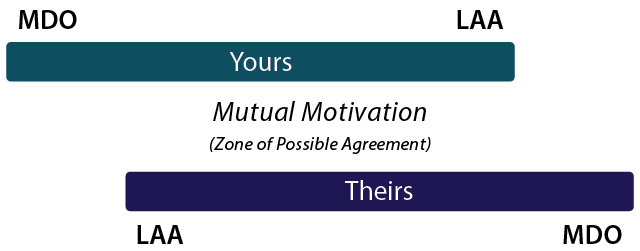The Negotiating Envelope
- It is easier to create value when you know your parameters
- A prepared negotiator is a successful negotiator
- Your goal is a likely and easily reached outcome
- Your Best Alternative To a Negotiated Agreement (BATNA) is a well-conceived plan
In the Preparation stage, you have to develop your Negotiating Envelope: Goals, Most Desired Outcomes (MDO), Least Acceptable Agreements (LAA), and Best Alternatives to a Negotiated Agreement (BATNA).
Whether a simple or complex negotiation, it is easier to create value when you know the hard lines that form your parameters. If you know the edges you don't intend to cross, you can be more flexible and creative within bounds:
- How high/low can you go?
- How long can you take?
- What should you hold in reserve?
- What is reasonable in this situation?
- And at what point should you walk away?
Imagine you are a mountain climber. If you know how high the mountain is, the point at which most climbers consider success, and where beginners tend to drop out, you can more easily plot your route and determine needed supplies. You can feel satisfied with your performance because you can measure your success in line with the conditions that arose on your trip – weather, team experience, hazards, etc. You can determine whether to stay, climb, or go back because you have a good idea of what is reasonable for the existing conditions.
This is your Envelope of Reasonability.
For a mountain climber the envelope holds the parameters of the climber's trip – guidelines that will help determine when to hang in there and when to retreat, and a measurement of success.
For a negotiator, the envelope of reasonability guides your trades in the negotiation – when to move, how far to go, and when to retreat. Knowing your envelope of reasonability allows you to explore creative options that fit in the envelope, and to measure your success along the way.
What makes your envelope one of Reasonability, as opposed to dreams and doubts, is that it addresses interests – yours and theirs.
* Fisher, R. and Ury, W. and Patton, B. 2011. Getting to Yes. 3rd. Edition. New York, NY: Penguin Books
Define Your Negotiating Opportunity – Your Envelope of Reasonability
Before any negotiation you will identify your:
MDO - Most Desired Outcome What you want and can defend
Goal - The more likely outcome that also addresses mutual interests
LAA - Least Acceptable Agreement What you need before walking away
BATNA – Best Alternative to a Negotiated Agreement What you do if no agreement

- Do not anchor yourself: Always develop your MDO first, then your goal, then your LAA.
- The negotiation is a fluid process. You do not stop refining your MDO, Goal, LAA, and BATNAs at the Preparation Stage. Explore all the creative opportunities that might be viable – and continue to do that throughout the negotiation process.
MDO
Your Most Desired Outcome is the result you want and can defend.
- MDO is your fact-based plan for your opening proposal.
- It is everything your want and can defend.
- It is bold and assertive, but not aggressive.
- Although it is not always achieved, the MDO is achievable. If no one has ever gotten the MDO you seek, it is possibly too aggressive and not defensible.
- The MDO challenges you and the other side to be more creative.
- MDO is your fact-based plan for your opening offer: Start High. Start Low. Just don't start in the middle.
- Must-haves are included in your MDO.
- Often also called your Stretch Goal.
Goal
Your Goal is a likely and easily reached outcome that addresses both parties’ interests.
- A negotiator’s goal, like all goals in life, is
- Definable,
- Measurable,
- Attainable,
- Shared internally, and
- Aligned externally.
- Research shows that people with well-defined goals achieved outcomes closer to their MDO, and those without well-defined goals end up closer to their LAA.
LAA
Your Least Acceptable Agreement is the minimum you need before walking away.
- It is the minimum you are willing to accept, and so forms one of the outside parameters of your negotiating envelope.
- If you can achieve any result between your LAA and MDO, you are better with an agreement than without one.
- Your LAA is broader than a bottom line because it satisfies interests and covers multiple issues. Bottom line has a more negative connotation as an unsatisfactory result taken reluctantly.
Your Best Alternative To a Negotiated Agreement is a well-conceived plan that you are willing to execute if there is no agreement. Your Plan B.
- A prepared negotiator is a successful negotiator. Determine your Most Desired Outcome (MDO), Goal, Least Acceptable Agreement (LAA), and Best Alternative to a Negotiated Agreement (BATNA), and make assumptions that can be tested about the same data points for the other side

Mutual Motivation – the place where you assert positions to address aligned interests.
Zone Of Possible Agreement (ZOPA) – Describes the intellectual zone in negotiations between two parties where an agreement can be met and to which both parties can agree. Within this zone, an agreement is possible. Outside the zone no amount of negotiation will yield an agreement. Sometimes referred to as the "bargaining range."
If You Like This Content, You’ll Love Our Training Workshops
We provide in-person and virtual training workshops to companies, government agencies, universities, and other organizations. The content of this Learning Center is a small sample of what we deliver to your teams during our live interactive classes.
To learn more, send us a note and we will be in touch soon!